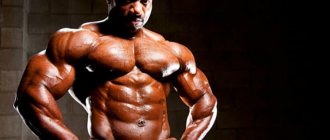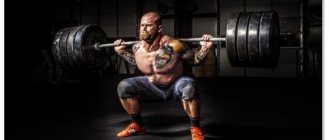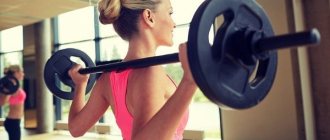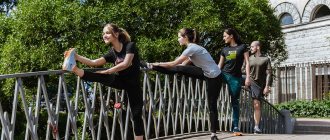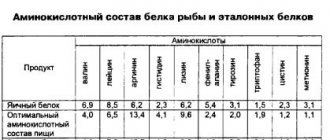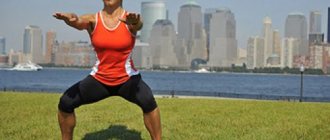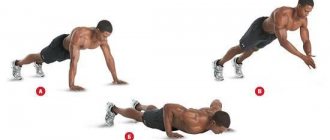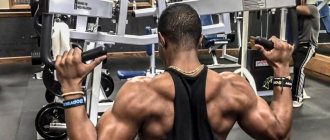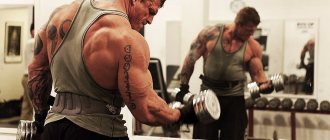Powerlifting is ideally suited to the use of block periodization principles. This is because there are not many target physical qualities in it: maximum strength, absolute strength, and technique.
Note : Please note that this article is written for powerlifters, NOT for general physical training coaches. The author does not set out to describe the scientific background of the system. The purpose of the article is to outline the basic principles and provide an understanding of how to apply the method in practice.
How I learned about block periodization
I first heard about block periodization when I interned with Buddy Morris and James Smith at the University of Pittsburgh. James told me a little about this system, I was interested, but overall I was skeptical because it was nothing like what I was doing. Moreover, I did not understand the terminology he used and how to apply it. During this period, I was still using a similar training regimen to Westside, and did not want to change anything, since I had received good gains from it in the past.
I continued to train using Westside principles, but I was often injured. Also, the results were very inconsistent because I rarely did competition movements. As a result, after a series of injuries and competitive failures, I decided to take a little break from powerlifting. After moving to Washington, I met Carlos Oseguieda, manager of the Central Virginia Athletic and Barbell Club. Carlos said that he trains according to the principles of block periodization and is making good progress.
This time, I decided to understand better and purchased books by Vladimir Issurin: Block Periodization: A Breakthrough in Sports Training and Principles and Basics of Advanced Athletic Training. These books revealed to me the principles of block periodization, so for the next year, through trial and error, I adjusted the training plan to suit myself. Working out according to this system, I added 86 kg to my total and fulfilled the elite standard in cat. up to 110 kg.
What is block periodization?
Issurin’s book offers the following definition: “The general approach to the formation of training according to the principles of block periodization involves the sequential alternation of three blocks - mesocycles, which are combined into one training cycle, ending with a competition.” In other words, this system involves working on general physical qualities, and gradually changing the focus to the required ones as the competition approaches. Taking into account the above, you should be able to distinguish between general exercises, general - special and special ones.
Let's look at the concepts using the example of exercises for an American football lineman:
- General - TA movements, PL movements, other exercises with a barbell, dumbbells, kettlebells, etc.
- General - special - pushing loaded sleds, rolling tires, special dummies.
- Special - work 1 on 1 against a partner in a time period of 4 - 10 seconds.
Based on these concepts, any lifter can create similar blocks of exercises depending on their weak points. This is why two lifters using the pulley system may have completely different workouts. Only one thing is constant: the training plan corresponds to the requirements of three mesocyclic blocks - cumulative, transformative and implementation.
https://youtu.be/bW2m7_amMCc
Phase one – duration six weeks
- We train to gain good muscle mass.
- We improve speed and strength indicators.
- We train the correct technique for performing exercises.
- We tighten up our weak points.
- We stretch the body and work out the joints.
Gaining muscle mass - to complete this task, you need to first perform basic exercises that can shock your muscles. We recommend performing exercises with an intensity of 55-75% of the maximal maximum (maximum maximum). It's best to do 8 to 10 reps per set. Also pay attention to a properly structured diet, try to consume more carbohydrates and protein. Recovery – spend at least 8 hours a day of continuous sleep. Now let's look at some tips on the technique of performing basic exercises, namely the bench press, squats and deadlifts.
Bench press
- The more your back is arched in the lower back, the shorter the range of motion.
- Try to bring your shoulder blades together, this also reduces the amplitude, and in addition you will more confidently take the barbell to your chest.
Deadlift
- When performing deadlifts, do not bend your back under any circumstances.
- At the very beginning of the motor stage, involve only your legs in the work.
- Do not try to make sudden movements, in terms of jerking and throwing the projectile.
Squats with a barbell on your shoulders
- While squatting, keep your back straight.
- The trajectory of the back should not deviate from the vertical, except at a minimum.
- Don't push your knees too far out in front.
- Do not bulge the pelvis backwards.
- Perform heavy exercises with the help of a support suit and bands.
Cumulative mesocycle
The cumulative mesocycle can be compared to building the foundation for a house. The intensity is low, but the volume is high. Training includes mostly general and general - special exercises. Not many special moves are used. In powerlifting, the goal of this block is to hypertrophy and improve overall performance. The percentages are selected individually, but usually range from 50 to 70%. When calculating the volume, I relied on Prilepin's table. The duration of the block can vary from 2 to 6 weeks. Once again, a lot depends on the individual lifter and training level. The lower the level, the longer the mesocycle. The block length may also vary depending on the annual plan. The deload phase of recovery after this block is optional, but may be included depending on the lifter.
Cycling training
Cycling
Cycling
is one of the methods of periodizing a training program within one cycle. Cycling involves changing only the intensity and volume of the training program. It is not related to the number of exercises and sets. The number of exercises, sets, and classes per week is determined by periodization (although very often in the literature cycling and periodization are mixed and interpreted differently).
Thus, the main idea of cycling in bodybuilding is to gradually increase the total load over certain periods of time and soften the load after reaching a certain maximum, at which subsequent maintenance of the rate of change in the load will not lead to a proper response from the body and, in particular, the process of muscle synthesis fabrics.
https://youtu.be/rip0PDSk7vw
Planning a training cycle according to V. Protasenko for entry-level athletes
Transformative mesocycle
It is used to transform an increased level of motor abilities into the athlete’s sport-specific preparedness. During this phase, the intensity increases and the volume decreases (but is still at an average level). Among the movements, special competitive ones appear, but the volume of general special movements that develop competitive ones remains large.
The priority of general exercises is reduced, but their implementation is still allowed, in a reduced volume. The purpose of this block is to develop the required qualities to perform competitive movements. Percentages for this mesocycle are typically in the range of 75 – 90%. I repeat, I took Prilepin’s table as a basis. In some cases, it is permissible to change the volume downwards. The length of the mesocycle is 2 - 4 weeks, but may vary depending on the annual plan.
Another important aspect of the mesocycle is that it is designed to create fatigue. There will be no full recovery between workouts in this cycle. In other words, it's normal to feel like crap throughout the block, but you should still be able to accomplish everything you planned. This block is the heaviest. Pay close attention to your volume and intensity, as it's easy to overtrain. Upon completion of the block, time should be allocated to restore unloading.
Microperiodization and periodization of training in bodybuilding
As a rule, all athletes who work out in the gym face the problem of a “weight plateau.”
This is a state when you either cannot progress at all, or you are progressing, but extremely slowly. Nobody likes it. Well, except perhaps for those eternal beginners who lift the same weights in the gym year after year and hope for some kind of progress. Which one, I don’t understand. One of the ways to overcome this “ceiling” is precisely the periodization of training, which we will talk about today. Hello, friends. Today I want to tell you what microperiodization of training is and how it works. The question is very interesting, so I want to analyze it in detail and give some practical recommendations.
https://youtu.be/v7jrtdXpxj8
I would like to say right away that beginners DO NOT NEED this thing! They are not yet working with weights that are as close to potentially possible and are training far from their maximum strength. It is difficult to overtrain the body with such loads. But for athletes who have already reached an average level, this technique will be simply necessary.
It is needed for several reasons:
- Avoid overtraining.
- Break through the “weight plateau”.
- Hypertrophy of sarcoplasm.
To avoid overtraining, you need to start alternating light and heavy workouts at a certain stage, because... It is impossible to constantly train to the limit of your capabilities and regularly progress linearly. The body, otherwise, will most likely fail, and this, as you understand, will significantly slow down progress.
Breaking through the “weight plateau” is necessary if you want to make more progress, because... THERE IS NO POINT FOR MUSCLES TO INCREASE IF THE LOAD DOES NOT INCREASE! When your weight on the bar is not growing and your training volume has stagnated, then significant progress is out of the question.
The swelling of the muscle cells that are located in these myofibrils is called MYOFIBRILL HYPERTROPHY (myofibrillar hypertrophy) or “bloating” of the cells.
But myofibrils are not the only structures that can grow in our muscles.
In the textbook of biological chemistry, authored by T.T. Berezova and B.F. Korovkin provides information that 80% of MUSCLE FIBER IS occupied by MYOFIBRILS, AND 20% BY OTHER STRUCTURES, INCLUDING SARCOPLASMA!
None of this is difficult, friends. There is LIQUID around the myofibrils, which is called SARCOPLASMA! Essentially, SARCOPLASMA is just WATER, with a certain amount of other substances dissolved in it (glycogen, ATP, creatine phosphate, fatty acids, amino acids, etc.)
Muscular fascia is a connective tissue membrane, the so-called. A SAC that is filled with myofibrils and sarcoplasm.
So, THE VOLUME OF SARCOPLASMA IS ALSO CAPABLE OF INCREASING! An increase in the volume of sarcoplasm is called SARCOPLASMIC HYPERTROPHY (hypertrophy of sarcoplasm)!
Specific schemes will follow.
This is an important point. Let's be brief again.
- Our muscles consist of: MYOFIBRILLS SARCOPLASMA, which are located in the BAG - MUSCULAR FASIA. There are other structures, but for us now the important ones are those that MOST influence muscle growth.
- Both myofibrils and sarcoplasm are susceptible to hypertrophy! Fascia, by the way, is also capable of stretching, but this will be discussed in a separate article, so don’t miss it.
Just recently there was no such concept at all. Bodybuilders have always trained hard and did not even think that alternating the nature of the loads could give them greater progress.
Periodization of training is a stepwise cycling of the focus, intensity and volume of training to achieve maximum strength and mass.
https://youtu.be/Q54e6BYAEwU
I think it’s clear that in order to develop maximum muscle growth at a certain stage (after 1-1.5 years of training) you need to train ALL MUSCLE STRUCTURES.
For this purpose, periodization of loads using training cycles is used.
Let's understand a little about training cycles.
Exist:
- Macrocycle.
- Mesocycle.
- Microcycle.
A MACRO CYCLE, as a rule, in bodybuilding consists of three phases:
- Strength training (2-4 weeks).
- Hypertrophy, “working for mass” (8-12 weeks).
- Drying (8-10 weeks).
Each of these phases is called a MESO CYCLE (strength, mass gain, drying) and lasts differently. The weeks that make up mesocycles are divided into MICROCYCLES.
This macrocycle is “classical” due to its consistent change in volume and intensity of each phase. Those. as it moves from the power mesocycle to drying.
The main thing in bodybuilding is MUSCLE MASS AND BODY AESTHETICS. Strength plays an auxiliary function. That is why the classical macrocycle is built as I showed above.
It begins with the strength training mesocycle (2-4 weeks), then comes the longest and most important mesocycle of muscle gain (8-12 weeks), and then comes the cutting mesocycle, during which we try to burn as much fat as possible and maintain as much fat as possible. as many muscles as possible.
This is the so-called LINEAR PERIODIZATION of training. It is quite good, but its disadvantage is that we develop only ONE biomechanical quality to the detriment of another quality.
Those. During the strength mesocycle we lose endurance, and during high volume training we begin to lose strength. To all this we must add that during any linear mesocycle we can train only one type of muscle fiber. Here's a cool article about the different types of muscle fibers.
To develop several or all muscle structures it is necessary to use microperiodization. Large loads should alternate with small and medium ones.
There are a LOT of options, but I will tell you about the ones I used myself. I liked the effect and the feeling too.
https://youtu.be/oonF2TpCcOo
We will need to give different loads for each muscle group in each workout. I'll give an example of several routines, starting with a person who will be using microperiodization for the first time, to someone who wants to increase the intensity.
The main problem with linear periodization is that it assumes that you have essentially the same amount of energy every day. Non-linear periodization will give you the weapons to achieve new victories in every workout.
Today you can find many different training programs on the Internet or in “fashionable” fitness publications. From fitness gurus, bodybuilding champions and other celebrities. And almost every scheme offered to a wide range of readers is a list of “boring” training plans. Almost all of them assume linear periodization.
Let's take a closer look at this concept.
Periodization is the basis of an athlete’s training regimen, which ensures progress in results (strength, speed, endurance, muscle mass, defined muscles, low fat content).
Read more: Why do athletes need glutamine: how to take it
These load changes are divided into periods. Hence the name “Periodization“. The periods can be different - 1-3 weeks (microcycle), 2-4 months (mesocycle), a whole training season (macrocycle).
“Linear periodization” - throughout the macrocycle, the specificity, intensity and volume of training increases or decreases at a linear rate, evenly, or with small changes and daily adaptation to the new load.
Linear periodization is well suited for coaches who work with large groups of athletes or with a large number of personal training sessions. Because it is too difficult to develop a more flexible training system and keep track of individual results for a large number of athletes.
Let's say you have the following training plan:
- Monday - 4x5 squats, working weight 85% of 1RM
- Wednesday - 4x5, working weight 85% of 1RM
- Friday - 4x5, working weight 85% of 1RM
This phase takes you about 6 weeks, during which you perform the same exercises, increasing the weight every Monday, Wednesday and Friday. After 6 weeks you finish the program and your working weights have increased. As you would expect based on the patterns of recovery, compensation, and training progress you know.
Nonlinear periodization
Next comes a new phase—“work on the relief.” We significantly reduce the working weights and perform a large number of repetitions in each approach to give the body a leaner appearance. So you work for another 6 weeks. You develop good endurance. But... now you've lost some of the muscle mass you worked so hard to gain during the hypertrophy phase, and you're even further away from the high strength levels you gained 12 weeks ago.
Linear periodization model with three controlled indicators: training volume (V), intensity (I) and technique (T). Phases: preparatory, recovery (transitional) and competitive with subsequent recovery
Variable periodization:
%RM
x number of approaches x number of repetitions
Realization mesocycle
The implementation block is the final stage of pre-competition preparation. Volume is low, intensity is high. Because of this, some call it a “spire.” In this mesocycle, training is focused on competitive movements. In general - special exercises are practically excluded, and general exercises, if used, are used exclusively for the purpose of preventing injury, or for blood circulation.
The load is used from 90%. Exercises must be performed in accordance with the rules of your federation. Enough time should be allowed between workouts for complete recovery. The frequency of training has also been reduced. The block usually lasts about two weeks; Upon completion, time should be allocated for recovery and unloading (1 - 2 weeks) in accordance with individual needs.
Let's put it all together
If you have read up to this point, it means that you have made your way through all my writings, and you have a general understanding of the system. Now you're probably thinking, “Well, yeah, I need to raise the amount. How to write a training plan? The bad news is that I can't give you a definitive answer. I don’t know your weak points, I haven’t seen your technique, I have no idea about your level of training, I don’t know how many times a week you train, etc. But what I can do is offer a few different examples of how this system can be used.
I will provide excerpts of what I have used and what has worked well for me. Based on this, you can change something for yourself. I repeat: everything stated below is just an example. You certainly don't have to take everything literally. I also did not include warm-up, recovery information, etc., since these are all individual things.
Transformative mesocycle
It is during this mesocycle that many athletes have questions about planning. To fill this gap, I have added several working diagrams to the article.
The percentages set out below should be treated as a guide. Minor adjustments are acceptable. The only thing that can cause confusion on the scale is equipment. It is very important to take your actual training maximum as a basis. When performing certain movements, you should take into account the technique, and base the seto - repeated y pattern - on this. Also, count the percentages of the maximum in a special exercise, do not even think about taking them from a competitive exercise, for example, a squat. Otherwise, don't be surprised why you were suddenly crushed by a barbell.
First example: Transformational mesocycle (4 training days per week)
Day 1: Press
Press in a T-shirt 75 - 90% 4 - 12 repetitions total
Board press (with or without a shirt) 75 - 85% or based on Subjective Load Rating (SRR) 6 - 15 reps total
Horizontal rows 30 - 40 repetitions total
Stretching a rubber band in front of you with straight bent arms 30 - 40 repetitions in total
Day 2: Cravings
Competition Rows 75 - 90% 4 - 12 reps total
Squat with safety squat bar on a low box 75 - 85% or based on ROP 6 - 15 reps total
Romanian deadlift with snatch grip 3 - 4 sets 6 - 10 reps *based on RPT
Abs, upper back, hamstrings 2 - 3 sets for each muscle group 12 - 20 repetitions
Day 3: Bench
Press in a T-shirt 75 - 90% 4 - 12 repetitions total
Close-grip incline press 3 - 5 sets 6 - 10 reps *based on ROP
Vertical row 30 - 40 repetitions total
Raises arms in front of you 30 - 40 repetitions total
Day 4: Squat
Squat in briefs or a suit without straps, or both 75 - 90% 4 - 12 repetitions total
Rows in the rack (= from the plinths) 75 - 85% or based on RNC 6 - 15 repetitions total
Narrow stance TA style squat 3 - 4 sets 6 - 10 reps *based on ROP
Abs, upper back, lower back 2 - 3 sets for each muscle group 12 - 20 repetitions
This is the basic split for the transformative mesocycle. Everything given above is suggested for athletes performing in equipment. If you compete in the raw division, everything remains the same, just done without equipment. Percentages and sets - repeated patterns remain unchanged.
Training becomes more narrowly focused, because either competitive movements or their variants are taken. On bench press days, horizontal and vertical rows are present, only in a reduced volume, compared to the accumulation block. On squat days, the primary movement is the competition squat, followed by a deadlift specific (SP) exercise, and then a general squat specific (OC) exercise at a lower intensity. On deadlift day, everything is the same, only in reverse - deadlift - SP - squat - OC - deadlift. On these two days, general exercises should be done in a “circular” style to maintain the level of general physical fitness. If necessary, this part is removed, depending on how you feel. The intensity of circular work is low.
This scheme has its pros and cons. Pros: such a volume of special and general special work will better “translate” into results in competitive movements. Cons: training in this style takes a lot of time. Using basic, multi-joint exercises, you have to pay more attention to technique, and, as a result, take longer rest breaks between sets. In addition, a 4-day split is not suitable for everyone, due to the work week schedule. For some, time for recovery will not be enough. Others may need more general exercises to target a specific area due to an old injury, weak spot, etc. P.
Here is another example of a 4 day split
The press days remain the same, but there are slight changes made to the squat and deadlift days.
Day 1: Press
Press in a T-shirt 75 - 90% 4 - 12 repetitions total
Board press (with or without a shirt) 75 - 85% or based on Subjective Load Rating (SRR) 6 - 15 reps total
Horizontal rows 30 - 40 repetitions total
Stretching a rubber band in front of you with straight bent arms 30 - 40 repetitions in total
Day 2: Cravings
Competition Rows 75 - 90% 4 - 12 reps total
Squat with safety squat bar on a low box 75 - 85% or based on ROP 6 - 15 reps total
GHR (with weights or resistance bands) 32 – 50 reps total
Upper back - optional
Press
Day 3: Bench
Press in a T-shirt 75 - 90% 4 - 12 repetitions total
Close-grip incline press 3 - 5 sets 6 - 10 reps *based on ROP
Vertical row 30 - 40 repetitions total
Raises arms in front of you 30 - 40 repetitions total
Day 4: Squat
Squat in briefs or overalls without straps, or both 75 - 90% 4 - 12 repetitions total
Rows in the rack (= from the plinths) 75 - 85% or based on RNC 6 - 15 repetitions total
Reverse hyperextensions 3 - 5 sets 8 - 12 reps
Press
As you may have noticed, in this version of the split there are fewer general and special exercises. Training will not be as time-consuming, and those who find it difficult to remove such a variable as “real life” from the equation will find it a little easier to recover. In addition, it is permissible to add general exercises to work on weak points.
Some of you may have various other obligations in addition to work. Since the option of dismissal and divorce does not suit you, you can try the scheme given below. The scheme will work if higher powers (family, work, etc.) allow you to train 3 days a week, without limiting your time. This option is also suitable for those who are recovering well and want to add special and general exercises. A bonus to this scheme is the opportunity to work on the big three special and general special exercises.
Third example: Transformative mesocycle (3 training days per week)
Day 1: Press - Deadlift - Squat
Press in a T-shirt 75 - 90% 4 - 12 repetitions total
Thrusts in the frame (= from plinths) 75 - 85% or based on RNC 6 - 15 repetitions in total
Narrow stance TA style squat 3 - 4 sets 6 - 10 reps *based on ROP
A few sets of lats, abs, or whatever you have time for.
Day 2: Deadlift - Squat - Press
Competition Rack Row 75 – 90% 4 – 12 reps total
Squat with safety squat bar on a low box 75 - 85% or based on ROP 6 - 15 reps total
Close-grip incline press 3 - 5 sets 6 - 10 reps *based on ROP
A few sets of hamstrings, abs, or whatever you have time for.
Day 3: Squat - Press - Deadlift
Squat in briefs or overalls without straps, or both 75 - 90% 4 - 12 repetitions total
Board press (with or without a shirt) 75 - 85 or based on ROP 6 - 15 reps total
Romanian deadlift with snatch grip 3 - 4 sets 6 - 10 reps *based on RPT
A few sets on the lower back, abs, or whatever you have time for.
If you only have the opportunity to train 3 days a week for a limited time, the scheme outlined below will be the optimal solution. It will not contain so many general and special exercises, but the basics will be the same as in the diagram above.
Fourth example: Transformative mesocycle (3 training days per week)
Day 1: Press - Deadlift
Press in a T-shirt 75 - 90% 4 - 12 repetitions total
Thrusts in the frame (= from plinths) 75 - 85% or based on RNC 6 - 15 repetitions in total
Horizontal row 3 sets 10 - 15 reps
Reverse hyperextensions 3 sets 10 - 15 reps
Day 2: Deadlift - Squat
Competition Rack Row 75 – 90% 4 – 12 reps total
Squat with safety squat bar on a low box 75 - 85% or based on ROP 6 - 15 reps total
GHR 30 – 50 reps total
Press
Day 3: Squat - Press
Squat in briefs or overalls without straps, or both 75 - 90% 4 - 12 repetitions total
Board press (with or without a shirt) 75 - 85% or based on Subjective Load Rating (SRR) 6 - 15 reps total
Goodmoning with rubber bands 40 - 60 repetitions total
Dumbbell press 30 - 50 repetitions total
And finally, another version of the program for the transformative mesocycle. I know that many lifters like to use resistance adjustments in their training, especially those who compete in multi-layer equipment.
I will outline my position on adjusting resistance: I do not consider it necessary to use it in special exercises, since one of the goals of such exercises is to improve technique. Rubber bands change the dynamics of movement. True, the same cannot be said about chains. Of course, they can be used in special exercises, but, in most cases, it is better to leave them for general special exercises.
Below is an example of using bands and chains in general specific exercises within a 4-day split. The reason I use SRR (Subjective Rating of Load) is because it's pretty hard to give a person percentages when you don't know how exhausting the main exercise is for them. And with the use of drag adjustment, it becomes even more difficult to tell.
Day 1: Press
Press in a T-shirt 75 - 90% 4 - 12 repetitions total
Board Press with Resistance Bands Based on Subjective Load Rating (SRR) 6 – 15 reps total
Horizontal rows 30 - 40 repetitions total
Stretching a rubber band in front of you with straight bent arms 30 - 40 repetitions in total
Day 2: Cravings
Competition Rows 75 - 90% 4 - 12 reps total
Box Squat with Bands and Chains Based on RRP 6 – 15 reps total
GHR (with weights or resistance bands) 32 – 50 reps total
Upper back - optional
Press
Day 3: Bench
Press in a T-shirt 75 - 90% 4 - 12 repetitions total
Close-grip incline press 3 - 5 sets 6 - 10 reps *based on ROP
Vertical row 30 - 40 repetitions total
Raises arms in front of you 30 - 40 repetitions total
Day 4: Squat
Squat in briefs or overalls without straps, or both 75 - 90% 4 - 12 repetitions total
Rows in the frame (= from the plinths) with rubber bands Based on the RNC 6 - 15 repetitions in total
Reverse hyperextensions 3 - 5 sets 8 - 12 reps
Press
Basic principles of cycling
Cycling the load allows you to avoid the presence of “weak points”, since the athlete periodically places emphasis on the development of different speed and strength indicators, and also, what is especially important, periodization allows you to avoid overtraining, since at an advanced level linear progress, sooner or later, leads to stagnation . Cycling methods were developed by such methodologists as Georgy Funtikov, Yuri Verkhoshansky, Anatoly Chernyak and others. Methods were developed for weightlifting, and accordingly, they have to be optimized for powerlifting and bodybuilding, which has already been done for the first, but not yet for the second. This is due to the fact that professional powerlifters use cycling, and professional bodybuilders proceed from simpler training schemes, since the specifics of training, when using pharmacology, for hypertrophy of muscle structures, do not require such a strict cycling system. But in natural bodybuilding, periodization is necessary, since “naturals” progress only with progress in speed and strength indicators.
There are different approaches to periodization in bodybuilding, but they are all based on the same principles. There are three different cycles in terms of time frame and nature - microcycle, mesocycle and macrocycle.
Microcycle
– a short cycle (several days, most often a week), including several separate workouts.
A mesocycle is made up of several microcycles
.
The mesocycle is a phase
of the training process that pursues certain goals - increasing muscle mass, improving strength performance, fat burning and relief (or the so-called “drying”). As a rule, in addition to full-fledged training microcycles aimed at the chosen goal, a less severe softened microcycle is added at the end of the mesocycle. Moreover, the higher the load in the “main” microcycles, the lower it should be in the “recovery” cycle. The average duration of the mesocycle is about a month, but can reach 8-12 weeks.
Macrocycle
is a combination of several mesocycles, which together solve the main task of the training. The use of the macrocycle is most relevant for experienced bodybuilders and competitive bodybuilders.
Periodization at the initial stages of strength training can also be based on mesocycles. However, at an advanced level, in this case, one can observe a certain stagnation in the development of muscles and strength indicators, which is overcome by periodization within the annual macrocycle.
Widespread programs often involve the bodybuilder participating in competitions and providing for peak fitness during the competition period. Such a macrocycle includes a preparatory period, consisting of several mesocycles, which are specific phases in preparation, a competitive period, with the goal of achieving maximum (peak) form, and a transition period, restoring strength and preparing for the next annual cycle.
When planning cycles, it should be taken into account that if periodization is used in several exercises, the development of these cycles should occur in parallel to each other. Otherwise, the cycle will lose its advantage over the usual approach - there will be no periods during which the body recovers from increased loads, since during the recovery period in one cycle the load in another cycle will increase.
Realization mesocycle
The implementation block is the final piece of our puzzle. Training within this mesocycle is low-volume, high-intensity. Allow sufficient time between workouts for complete recovery. Typically, a block lasts 2 weeks. Some people will like the division of the main movements on different days of the week, others will like 2 workouts per week, with one day dedicated to bench presses, and the other to squat deadlifts.
After a special movement, it is permissible to perform several light auxiliary exercises of a general nature. The volume and intensity of these exercises should be low.
The scheme outlined below involves the use of light auxiliary exercises after performing the main movement. The purpose of such an ancillary is blood filling and a lighter version of the general physical condition. Assistive exercises should not take a lot of effort.
First example: Implementation mesocycle (3-day split)
Day 1: Deadlift
Competition stance, same equipment as will be used in competition 90% or more 1 - 4 reps
Reverse hyperextensions 2 sets 10 - 20 reps
Shrugs 2 sets 15 - 20 reps
Press 2 sets 15 - 25 reps
Day 2: Press
Press in competition equipment 90% or more 1 - 4 reps
Extensions with rubber bands 2 - 3 sets 15 - 20 reps
Horizontal row (easy) 2 sets 10 - 20 reps
Deltas with rubber bands 2 sets 10 - 20 reps
Day 3: Squat
Competition squat 90% or more 1 - 4 reps
Pull through with rubber bands
Leg curls with rubber bands 2 sets 10 - 20 reps
Press 2 sets 15 - 25 reps
Some lifters in the implementation block prefer to do 2 training days: one devoted to the press, the other to the squat deadlift. This case is described in the diagram below.
Second example: Implementation mesocycle (2-day split)
Day 1: Press
Press in competition equipment 90% or more 1 - 4 reps
Extensions with rubber bands 2 - 3 sets 15 - 20 reps
Horizontal row (easy) 2 sets 10 - 20 reps
Deltas with rubber bands 2 sets 10 - 20 reps
Day 2: Squat
Competition squat 90% or more 1 - 4 reps
Rows in a competition rack, the same equipment that will be used in competition 90% or more 1 - 4 reps
Reverse hyperextensions 2 sets 10 - 20 reps
Pull through with rubber bands
Press 2 sets 15 - 25 reps
Below is another diagram for executing the implementation block. Remember: additional training should be easy and help speed up recovery.
Third example: implementation mesocycle (2 days)
Day 1: Press
Press in competition equipment 90% or more 1 - 4 reps
Horizontal row (easy) 2 sets 10 - 20 reps
Day 2: Additional bench training
Hand raises with bands (flies) 2 - 4 sets 10 - 20 reps
Extensions with bands 2 - 4 sets 10 - 20 reps
Deltas with rubber bands 2 - 4 sets 10 - 20 reps
Stretching a rubber band in front of you with straight bent arms 2 - 4 sets 10 - 20 repetitions
Day 3: Squat
Competition squat 90% or more 1 - 4 reps
Deadlift in a competition stance, the same equipment that will be used in competition 90% or more 1 - 4 reps
Day 4: Additional squat workout
Reverse hyperextensions 2 sets 10 - 20 reps
Pull through with resistance bands 2 - 4 sets 10 - 20 reps
Leg curls with rubber bands 2 - 4 sets 10 - 20 reps
Press 2 - 4 sets 15 - 25 reps
Planning a training cycle
Before you use block periodization, you should determine how many weeks before the competition you have. Sometimes it’s even more convenient to count backwards from the day of the competition itself. This allows the lifter to determine how much time to spend on each block, when to add equipment work, when to do fast weeks, and how they can make adjustments if needed. Below is an 18 week training cycle. The blocks are divided by week and equipment used. I repeat, everything listed below serves only as an example, and is determined strictly individually, depending on the athlete’s experience, level of equipment proficiency, etc. The countdown is from the day of the competition in the opposite direction.
Week 1: Competition Week Week 2: Recovery Loading Week 3: Conversion Block (Full Outfit) Week 4: Implementation Block (Full Outfit) Week 5: Recovery Outloading Week 6: Conversion Block (Tank Top, Briefs, Jumpsuit or Both , at the discretion of the lifter) Week 7: Conversion block (t-shirt, briefs, suit or both, at the discretion of the lifter) Week 8: Recovery Week 9: Accumulation block (without equipment) Week 10: Accumulation block (without equipment) Week 11: Accumulation block (unequipped) Week 12: Recovery unloading Week 13: Conversion block (Unequipped or partially equipped) Week 14: Conversion block (Unequipped or partially equipped) Week 15: Recovery unloading Week 16: Storage block (without equipment) Week 17: Storage block (without equipment) Week 18: Storage block (without equipment)
How to create your own training program. Part 3: Load Cycling
https://youtu.be/DKa3hqAHXfA
The simplest way to cycle a given mesocycle is to alternate the level of volume of light, moderate and heavy training, when the athlete trains lightly for 1 week, moderately for the second, and hard for the third, while the intensity (% RM) increases linearly from the beginning to the end of the mesocycle. The mass gain mesocycle implies an intensity range of 40-80% RM (usually 60-80%). For example:
- Week 1: 1 workout: 70% RM x 15 reps x 3 sets (easy workout)
- Workout 2: 70% RM x 15 reps x 4 sets (moderate training)
- Workout 3: 70% RM x 15 reps x 5 sets (heavy training)
- 1 workout: 75% RM x 12 reps x 3 sets (easy workout)
- 1 workout: 80% RM x 8 reps x 3 sets (easy workout)
Many athletes vary intensity in a non-linear manner and may train in the 6-8 rep range and then the next week use a 12 or 20 rep set-up, which allows for different muscle fibers to be recruited and can provide energy.
In the case of split-program classes, the volume of training varies in a similar way. For example, with a 2-day split:
- Week 1: hard bottom workout, moderate top workout
- Week 2: moderate bottom workout, light top workout
- Week 3: light bottom workout, hard top workout, etc.
Read more: The best training programs for mass
Strength period (3-6 weeks): this is a mesocycle, which sometimes should replace purely bodybuilding schemes, during which the athlete works on his strength indicators in the range of 3 to 6 repetitions (RM more than 80%). In essence, this is the use of powerlifters’ layouts, which make it possible to give a qualitatively different load to the muscles, ligaments, joints, central nervous system and other body systems, due to which the athlete can increase working weights and, as a result, gain additional kilograms.
Drying (8-12 weeks): This is a period of reducing the level of subcutaneous fat. “Drying” is also called eyeliner for competitions in professional bodybuilding, which is aimed at dehydrating the body. However, a period of fat reduction must be included in the training plan, due to both practical and physiological factors.
The relevance of reducing the level of subcutaneous fat, in particular, is due to anabolic resistance, which a program for gaining pure muscle mass can avoid. In any case, 1-2 months a year must be devoted to “drying” in order to avoid both a number of side effects of a too long period of mass gain, and to unload the nervous and muscular systems. Training intensity can be in the range of 60-20% RM. Cardio training and interval training are also actively involved.
Read more:Training for relief
Strength period: this is the main mesocycle of a powerlifter, or strength athlete, during which the athlete trains at an intensity ranging from 60% to 90-95% of the repeated maximum. Accordingly, during this period the number of barbell lifts is not very high, and microcycling of the load is carried out mainly due to changes in the volume of training (total tonnage).
A simple periodization scheme is presented in Faleev's strength program, when an athlete takes an 8-12 week cycle, which he begins with low intensity, gradually bringing himself to a new repetition maximum. More complex load cycling schemes in powerlifting can be found in Georgy Funtikov and Anatoly Chernyak.
It is important to understand that mesocycling is carried out by isolating the strength cycle itself, in which the athlete trains in a certain intensity range, and microcycling is carried out by using different % intensity and load volume within the training cycle and, to a lesser extent, manipulating the CPS (the number of lifts of the barbell ).
Endurance: This is a training mesocycle that allows athletes to gain muscle mass and acquire the ability to work for a long time in the 8-12 repetition range, which, in general, correlates with the basic training schemes of bodybuilders. That is why periodization is rarely used within a cycle, or its simplest version is taken, when the athlete trains “hard” for one week and “light” for the second, independently choosing the relative intensity of heavy and light training.
The training is structured in such a way that the athlete can perform a simple or complex layout. A simple layout involves performing 4-6 working sets of 12 repetitions without increasing the working weight. A complex layout involves increasing the weight when the athlete performs 2-4 approaching sets of 10-12 repetitions and a final approach of 8. It would not be a mistake to increase the repetitions to 15-20 in the last approach, but reducing the working weight from approach to approach is prohibited.
Read more: Body mass index calculator for men
Speed: the mesocycle for the development of speed qualities is rarely separated into a separate training program, since there is no need for this; it can be included in a strength cycle, or any other. During this period, the athlete trains using ropes, chains, pauses and other methods outlined in the corresponding article on our website.
Peak Strength: This is typically a pre-competition training program that is used to build upon the entire previous training period and allow the athlete to perform at their peak in competition. During this period, the athlete uses intensity in the range of 70-90%, training in the range of up to 3 repetitions.
Auxiliary exercises are mainly specialized, that is, those that are elements of competitive movements, which allows you to level out weak points. The micro cycle during this period is also quite simple, the athlete simply alternates between light and hard weeks. Since the program cannot last more than 2-3 weeks, accordingly, the athlete trains hard for the first week, lightly for the second, then rests 2-4 days before the competition and goes on the platform.
Read more: Powerlifting training (best programs and exercises)
The figures indicate (in order from top to bottom) the number of weeks planned for a given training phase, the type of training performed in the phase, and the loading pattern (high, medium, or low). Even if the examples given do not cover the chosen sport, with proper understanding of the concept it is very easy to apply to each specific case. In addition, the presented set of examples can be used associatively.
- Rice. 1. Changing the load pattern during the strength training phases of a recreational baseball, softball, or cricket team. To maximize power development, the final two macrocycles feature two contiguous high-load cycles followed by recovery (low-load) cycles. Changing the load pattern during the strength training phases of a recreational baseball, softball, or cricket team. To maximize power development, the final two macrocycles feature two contiguous high-load cycles followed by recovery (low-load) cycles.
- Rice. 2. Proposed workload model for a college basketball team, according to which the preparatory phase lasts from July to October
- Rice. 3. Changing the loading model to periodize lineman strength development on a college football team. A similar approach can be used by track and field throwers and heavyweight wrestlers.
- Rice. 4. Changing the loading pattern for marathon canoeing, in which long-term muscular endurance is the dominant ability. A similar approach can be applied to cycling, cross-country skiing, eventing and rowing.
- Rice. 5. Changing the loading pattern for the first part of the annual plan with two cycles for sprinting in athletics
- Rice. 6. Changing the loading pattern for the short-distance swimmer (the first part of the annual plan with two cycles). The training of the last two stages is energy-intensive, since a high load is provided for two adjacent weeks.
- Rice. 7. Changing the load pattern for the long-distance swimmer. When training for maximum strength, the load should not exceed 80% of the repetition maximum. The load on muscular endurance is low (30 to 40%), but the number of repetitions is very high
At the same time, however, the opposite approach has a right to life if during training the option of working in accordance with bodybuilding methods is used. In this case, the number of repetitions performed per set exceeds the number of repetitions performed during the development of maximum strength and power, accordingly, the application of force occurs more slowly (taking more than 250 milliseconds).
Thus, this technique is not suitable for most sports. Because force application is typically very rapid in sports, the primary goal of sports strength training is to shift the force-time curve to the left or as close as possible to the sport-specific force application time (less than 200 milliseconds) by simultaneously training maximum strength and power. See Figure 9.
- Rice. 8. Force-time curves for two weight training programs.
- Rice. 9. The goal of strength training is to shift the force-time curve to the left.
- Rice. 10. The influence of the specifics of training during each stage on the behavior of the force-time curve
conclusions
Block periodization cannot be called a universal method. And it's not even about sets - repeated schemes, specific exercises or personal preferences. Block periodization is an organization scheme that classifies training from general to special. To successfully use this system, the lifter must be able to thoughtfully incorporate specific exercises into blocks that follow the principles of general, general-specific, and specific training.
Once a lifter understands this planning format, he will be able to successfully use the qualities developed in the early stages to improve his performance in the competitive squat, press, and deadlift. I hope this article got you thinking and cleared up any misunderstandings about block periodization.
With us you can.
A Practical Guide to Using Block Periodization in Powerlifting. Author: Gabrielle Naspinski.
How to Avoid Injuries in Powerlifting
When starting powerlifting classes, do not try to learn the technique of performing heavy, complex movements on your own; seek help from a coach or an experienced athlete; this will reduce your time and also reduce the risk of injury tenfold.
With the correct movement technique, the likelihood of injury (sprains, bruises, as well as ruptures of muscles, ligaments and tendons) is minimized.
Strength increases gradually, do not chase the weights on the bar, do everything according to plan and in a timely manner.
To support your lower back and spine when deadlifting and squatting, use a weightlifting belt. To protect your knees, you can use elastic bandages, bandages or special knee pads.
Powerlifting Belt Prices
Powerlifter training program - Pavel Badyrov:
https://youtu.be/mEqJTLlRGEU
